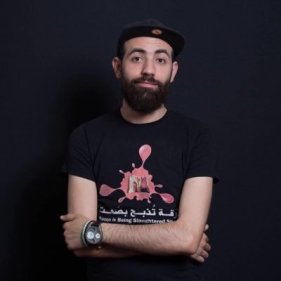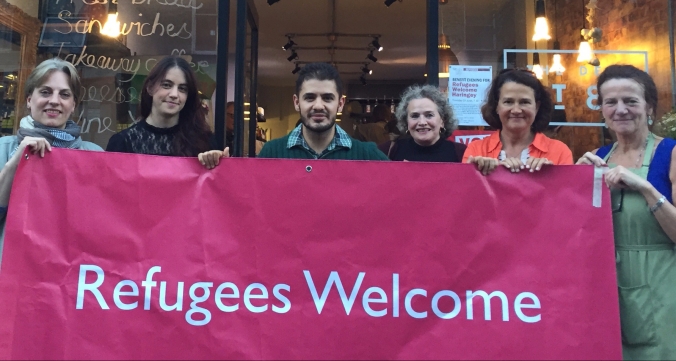Recently, every coffee, Skype call and pub lunch with my girlfriends has ended up in the same place: “Ugh. The world is such a mess. I feel so helpless.”
We try to console ourselves that it can’t all be that bad, really. But the evidence is stacked against us. A fascist is taking the reins of the free world. Britain is pulling itself apart over Brexit. Europe faces an unprecedented rise of the far right. And Syria, Iraq and Yemen are bloodied and scarred beyond recognition. And that’s just the beginning.
Meanwhile, the everyday battles over racism, homophobia, classism and misogyny still call for foot-soldiers. In this divided and unsettling world, it’s hard to see how any of us can make a difference.
The American anthropologist Margaret Mead wisely said: “Never doubt that a small group of thoughtful, committed citizens can change the world; indeed, it’s the only thing that ever has.” With this in mind, my friends and I set about formulating a theory; a simple way in which each individual can feel simultaneously empowered and involved, without being overwhelmed by the scale of the world’s problems. I call this “tessera theory”.
A tessera is a tile in a mosaic. Together, thousands of tesserae make up beautiful artworks and can cover pavements and cathedrals. Each tiny tile, on its own, has very little impact. But together with a thousand others, it becomes hugely valuable and impressive.
Of course, this is the theory behind mass protest. While a lone individual can occasionally grab headlines, a vast swathe of individuals blocking a highway or storming a palace is more likely to effect change. However, tessera theory is not about everyone moving together, en masse, towards the same goal. Tessera theory is about everyone making their individual contribution towards the goal that matters to them. Let me explain.
The problems of the world are vast. They are unmanageable for even the UN, EU or NATO. So it stands to reason that they can’t be fixed by you or me. But when we think in that way, we’re approaching the problem from the wrong direction. Tessera theory is about choosing the part that you’re going to tackle, alone or in a group, and ignoring the rest. Let’s break that down.
Step 1: What bothers you?
I’ve worked in NGOs for over a decade, and when I speak at conferences, students often ask me for career advice. They want to use their degree and/or their skills to make a difference, but they don’t know where to begin. The first step is so simple, but often overlooked: decide what matters to you.
This is important because you’re not going to stick at something if you’re not passionate about it. If you care about kids, don’t work for a donkey sanctuary, because you’ll spend all day on jobs.com trying to figure out your next career move. This applies to the stuff we do in our free time too: if something is important to you, you will make time for it. If it’s not, you’ll be forever procrastinating and making excuses not to get stuck in.
Draw a diagram – put yourself in the centre and write the concerns that you have around the page. The things that matter most to you, whether it’s LGBTI rights or arms control, should be placed closest to you. Things that matter less, that get less of your attention when you read the news, should be further away. You have a instant representation of where to focus your efforts.
Step 2: What capacity do you have?
Once you’ve picked a maximum of three areas that you want to focus on (one area is better, especially if you’re time-poor), figure out what capacity and resources you have. This time, divide a sheet of paper into three columns: skills, financial, and network. At the top of the page, write down the number of hours per week that you are willing to spend busting the problem(s) you identified in step 1. Then under each column write down the resources you have that will help you tackle the problem.
The “skills” column is about what you’re good at. Extroverts might be better at organizing conferences and demonstrations; introverts may be more comfortable making donations, writing articles or taking photos. The methods you choose should be just on the edge of your comfort zone, so that you’re not making things difficult for yourself, but at the same time you’re maximizing your capacity to make change. Skills to focus on can be as varied as: public speaking, cookery, blogging, networking, podcasting, connecting with people, writing, accountancy, events organizing and photography. Whether you’re an engineer, a dentist, a gardener or an artist, there will be an organization out there that meets your priorities for change and which can use your skills. And if there isn’t, set one up! All of the big charities and political organizations started this way.
“Financial” is about the amount of your own money that you’re willing to throw at the problem. For some people, making donations to organizations that represent their views is the best way to contribute. These people are generally time-poor and cash-rich. But not always. Just like the tessera in a mosaic, the pennies add up to vast sums when everyone contributes their bit. Similarly, if you want to organize an event or start your own group, you may need some cash to begin with. This could be for renting a space, printing promotional materials, paying guest speakers or building a website. Don’t bankrupt yourself; the point of this exercise is to see what’s manageable for each of us, so that we can each contribute our tessera in a sustainable way.
“Network” is about figuring out who can help you. If fundraising is your thing, it’s about listing who you can ask for cash. If you’re a mobilizer, the people on this list will be friends and contacts who can help you to organize events, who will be on your committee, or who will advise you on the areas where you are lacking skills. Get together with like-minded friends and brainstorm the kinds of people you need – expand your network by getting your friends to get their friends on board.
Your three columns will help you to understand your own capacity for making change. At different times of your life, your capacity will be different. If you’re a new parent, you might not be able to devote much time or any money. But you may be able to spend an hour per week mentoring somebody who has more spare time and energy, and who needs your professional knowledge in order to succeed in their activism. Or perhaps you could let a local group borrow your camera equipment or use your kitchen to hold meetings. If you’re a busy professional, foregoing that extra Thursday night cocktail could give you an extra £10/$10 per week to donate to Planned Parenthood or Doctors Without Borders. And if you can get your friends on board, that amount could soon become hundreds of pounds/dollars per month. And if you simply have no spare time at all, then just changing your shopping habits is a legitimate action for social change. Spend your money in charity shops and independent stores; buy ethical, and avoid the tax-dodgers and companies that refuse to recognize their workers’ rights. Some people’s tessera contributions are larger than others; your tessera might be made up of ethical consumerism, if that’s the only change you can reasonably make in your life right now. Re-evaluate your capacity when things change in your life.
Step 3: Switching off.
Once you have picked the area that you’re going to focus on, and decided what steps you can take to effect change, switch off from everything else. Seriously. So long as you’re genuinely doing the most you can do towards your chosen battle, there is no point wasting time getting depressed by all the other sad stories and bad news. A few rules here:
– NEVER engage with trolls on the internet. They sap your time and energy to do good things, and that’s how they win.
– Time with friends, whether it’s IRL or over the phone/internet, should be used to share positive messages and creative ideas. Have a “two-minute moan” rule, and then move on to sharing the good stuff that keeps you motivated.
– “Liking” and “sharing” is not the same as taking action. Only post stuff that motivates others to share in your actions. Putting a sad emoji next to a depressing news article won’t help anybody.
– Vicarious trauma is real. If the news is getting you down, turn it off. You’re no use to anyone if you’re traumatized and depressed.
– That said, keep informed about the area you’ve chosen to focus on. Find out who else is working on this issue and connect with them. Keep updated about the news on that topic so that you can make informed decisions.
And those are the rules of tessera theory. The maximum contribution from each individual, based on ability and capacity, all joined together to make an enormous mosaic of social change! It’s just a theory, so use the comments below to share your thoughts and ideas for improving it!
Saphia Fleury is a London-based editor specializing in human rights law and social justice issues. Her most recent publication as editor, Combating torture and other ill-treatment: A manual for action , was published by Amnesty International.





